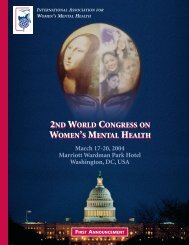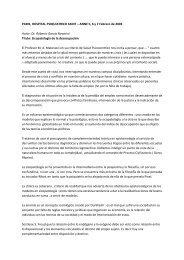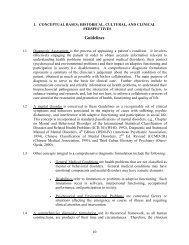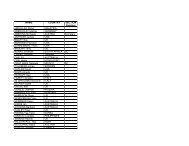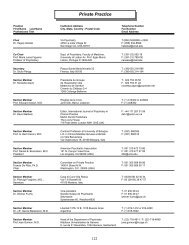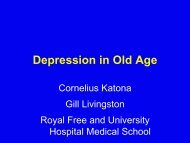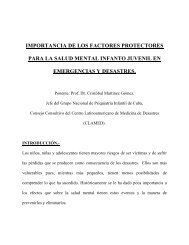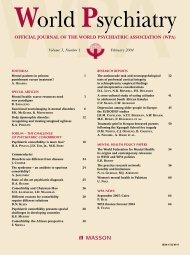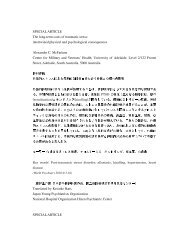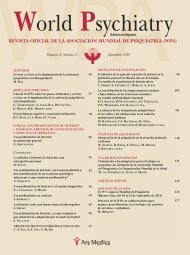ABSTRACTS - World Psychiatric Association
ABSTRACTS - World Psychiatric Association
ABSTRACTS - World Psychiatric Association
Create successful ePaper yourself
Turn your PDF publications into a flip-book with our unique Google optimized e-Paper software.
effects on bipolar non-mixed depression). Fluoxetine/olanzapine combination<br />
stands out, as it has shown similar efficacy in mixed vs. nonmixed<br />
bipolar I depression, in a large controlled study. It is noteworthy<br />
that fluoxetine (it cannot be inferred all selective serotonin reuptake<br />
inhibitors) added to second-generation antipsychotic olanzapine (it<br />
cannot be inferred all second-generation antipsychotics) was effective<br />
for mixed depression, while olanzapine alone was less effective (but<br />
better than placebo).<br />
RS3.2.<br />
BIPOLAR MIXED DEPRESSIONS: CLINICAL<br />
FEATURES AND RELATION WITH SUICIDALITY<br />
Z. Rihmer<br />
Department of Clinical and Theoretical Mental Health,<br />
Semmelweis University, Budapest, Hungary<br />
Mistreatment of mood disorders is one of the main causes of attempted<br />
and completed suicide. Since most mood disorder patients never<br />
commit or attempt suicide, investigating the clinical variables related<br />
to suicide in depression is a priority. A proximate suicide risk factor is<br />
mixed depression (depressive mixed states), i.e., depression plus cooccurring<br />
manic/hypomanic symptoms such as irritability, psychomotor<br />
agitation, talkativeness, and racing/crowded thoughts. The definitions<br />
most commonly used require at least 2 to 3 manic/hypomanic<br />
symptoms (not specific symptoms, such as psychomotor agitation).<br />
Mixed depression is not included in DSM-IV and ICD-10. Its frequency<br />
is higher in bipolar disorders (20 to 70%, depending on several<br />
factors), but it is not uncommon in unipolar depression. Suicide<br />
attempts and suicidal ideation are more frequent in mixed than in<br />
non-mixed (unipolar and bipolar) depression. We have recently found<br />
a much higher frequency of mixed (bipolar and unipolar) depression<br />
in depressed suicide attempters than in depressed non-suicide<br />
attempters. Suicide attempters had mainly a bipolar II mixed depression,<br />
explaining, at least in part, why bipolar II disorder carries the<br />
highest risk of suicidal behaviour among mood disorders. Diagnosing<br />
mixed depression as a possible suicide risk factor has important implications<br />
for suicide prevention, since antidepressant monotherapy<br />
(i.e., unprotected by mood stabilising agents) in a “missed” mixed<br />
depression can worsen its clinical picture by increasing the severity of<br />
manic/hypomanic symptoms. Antidepressant monotherapy in bipolar<br />
depression, but also in unipolar depression (especially with signs of<br />
bipolarity), can also induce the new onset of a mixed depression.<br />
RS3.3.<br />
THE DICHOTOMY WITHIN THE BIPOLAR<br />
SPECTRUM AND ITS RELATIONSHIP WITH MIXED<br />
DEPRESSION<br />
G. Perugi<br />
Department of Psychiatry, University of Pisa, and Institute<br />
of Behavioural Sciences G. De Lisio, Pisa, Italy<br />
The bipolar spectrum includes also many clinical, often recurrent,<br />
states, such as seasonality, high depression recurrence, recurrent irritability,<br />
neuroasthenia, periodical sleep disturbances, episodic obsessive-compulsive<br />
disorder, and social phobia followed by pharmacologically-induced<br />
hypomania. Impulsive behaviors such as selfaggression<br />
or aggression towards others, pathological gambling and<br />
paraphilias may also be bipolar spectrum disorders. Mood reactivity<br />
of cyclothymic temperament and impulsivity might be related, each<br />
characterized by disinhibited thinking and behavior, poor insight,<br />
and marked dysphoric and pleasurable mood changes. Eating disorders,<br />
bulimia nervosa and binge eating disorder could be related to<br />
impulse control disorders. Comorbidity among bipolar spectrum,<br />
anxiety and impulse control disorders represents a complex picture,<br />
susceptible of different pathogenetic interpretations. Probably, the<br />
pathological process underlying bipolar disorders extends beyond<br />
euphoric and depressive mood dimensions, including negative arousal<br />
affective states, such as anxiety, panic, irritability and impulsivity.<br />
Many bipolar spectrum patients, especially when recurrence is high<br />
and inter-episodic periods are not free of affective manifestations,<br />
may meet DSM-IV criteria for personality disorders. This is particularly<br />
true for bipolar patients with cyclothymic temperament, often<br />
misclassified as borderline personality disorder because of their<br />
extreme mood instability and reactivity. Actually, mood lability of<br />
cyclothymic temperament should be considered a core characteristic<br />
of a bipolar subtype characterized by early onset, high comorbidity,<br />
and more problematic lithium response. Cyclothymic temperament<br />
may facilitate the mixture of manic/hypomanic symptoms and<br />
depression (mixed depression). The distinction of bipolar disorders<br />
with/without cyclothymic temperament could be a more sensitive<br />
predictor of outcome, and may enhance clinical practice and research<br />
endeavours.<br />
RS3.4.<br />
TREATMENT OF BIPOLAR MIXED DEPRESSION<br />
WITH ADJUNCTIVE ANTIDEPRESSANTS: HELP<br />
OR HINDRANCE<br />
J. Calabrese, J. Goldberg<br />
Bipolar Disorders Research, Case Western Reserve University,<br />
University Hospitals Case Medical Center, Cleveland, OH; Mount<br />
Sinai School of Medicine, Affective Disorders Research Program,<br />
Silver Hill Hospital, Norwalk, CT, USA<br />
DSM-IV bipolar I “mixed state” requires co-occurrence of full depression<br />
and mania syndromes. However, there is less recognition of the<br />
prognostic relevance, prevalence, and impact of sub-syndromal symptoms<br />
of mania during major depressive episodes (MDE) in bipolar disorders<br />
(mixed depression). Most recent treatment guidelines advise<br />
against using traditional antidepressants in bipolar mixed depression,<br />
despite absence of large-scale, prospective, controlled trials of subjects<br />
with bipolar mixed depression. Longitudinal, naturalistic data<br />
from NIMH Systematic Treatment Enhancement Program for Bipolar<br />
Disorder (STEP-BD) have recently been analyzed to examine adjunctive<br />
antidepressant use in bipolar depressed patients with concurrent<br />
sub-syndromal manic symptoms (mixed depression), and to compare<br />
times until recovery. In 335 subjects treated with mood stabilizers<br />
with or without an antidepressant, adjunctive antidepressant use was<br />
associated with significantly higher mania symptom severity after 3<br />
months of follow-up, and probability of recovery was lower among<br />
patients with higher baseline depression severity. In 1380 MDE subjects<br />
with bipolar I or II disorders, the most common co-occurring<br />
symptoms of mania were distractibility, flight of ideas/racing<br />
thoughts, and psychomotor agitation. Bipolar mixed depression<br />
patients had more prior suicide attempts and rapid cycling, earlier age<br />
at onset, and more frequent bipolar I (vs. II) illness subtype as compared<br />
to those with “pure” depressed bipolar episodes. Emerging data<br />
suggest clinicians should assess all symptoms of depression and mania<br />
in every depressed patient at every visit, and recognize the risk that<br />
antidepressants may exacerbate concurrent mania symptoms without<br />
improving depression symptoms in bipolar mixed depression.<br />
33



